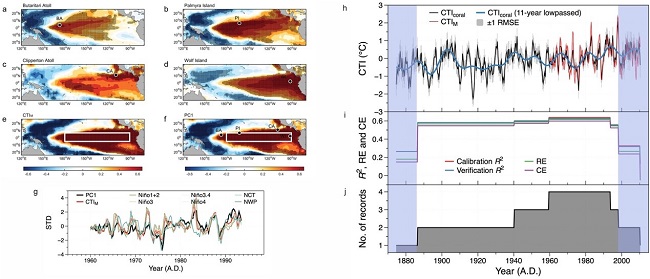Reconstructing Historical Temperature Variations in East Pacific Cold Tongue Using Coral Records
In the equatorial Pacific Ocean, strong upwelling caused by trade winds forms the East Pacific Cold Tongue (EPCT). Variations in sea surface temperature (SST) of the East Pacific Cold Tongue have significant impacts on global weather and climate.
However, due to low-quality observational data before the 1960s, there is still considerable controversy regarding SST changes in the EPCT during the 20th century. HadISST and Kaplan SST datasets indicate a long-term cooling trend during the 20th century, while ERSST and COBE SST datasets show a rapid warming trend in the EPCT. Reef-building corals widely distributed in tropical seas can provide high-resolution records of tropical climate changes over decades to centuries, offering new perspectives for studying this issue.
Recently, a joint research team led by Pof. YAN Hong from the Institute of Earth Environment of the Chinese Academy of Sciences, integrated the coral Sr/Ca-SST records in the tropical East Pacific region to reconstruct a seasonally resolved Cold Tongue sea surface temperature index (CTIcoral) from 1887 to 1997 AD.
The results show a rapid 20th century warming trend in the EPCT, suggesting that instrumental data underestimate the extent of warming in the Cold Tongue. On decadal to centennial scales, CTIcoral correlates well with the Walker circulation. In contrast, instrumental SST data before 1960 are decoupled with the Walker circulation, indicating potential bias in early 20th century SST data. Furthermore, reconstruction results also indicate that during the global warming hiatus period (1992-2011 AD), the cooling of the East Pacific Cold Tongue was not anomalous, similar magnitudes of cooling have been observed in the past.
This research was recently published in Geophysical Research Letters.

Fig.1 EPCT SST signal in the coral Sr/Ca‐SST records and coral‐based reconstruction of the seasonal Cold Tongue Index. (Image by HAN, et al)
Contact: BAI Jie, Institute of Earth Environment, Chinese Academy of Sciences, Xi'an, China. Email: baijie@ieecas.cn
 © 2015 Institute of Earth Environment,CAS
© 2015 Institute of Earth Environment,CAS Address:No. 97 Yanxiang Road, Xi'an 710061, Shaanxi, China

 Location :
Location :